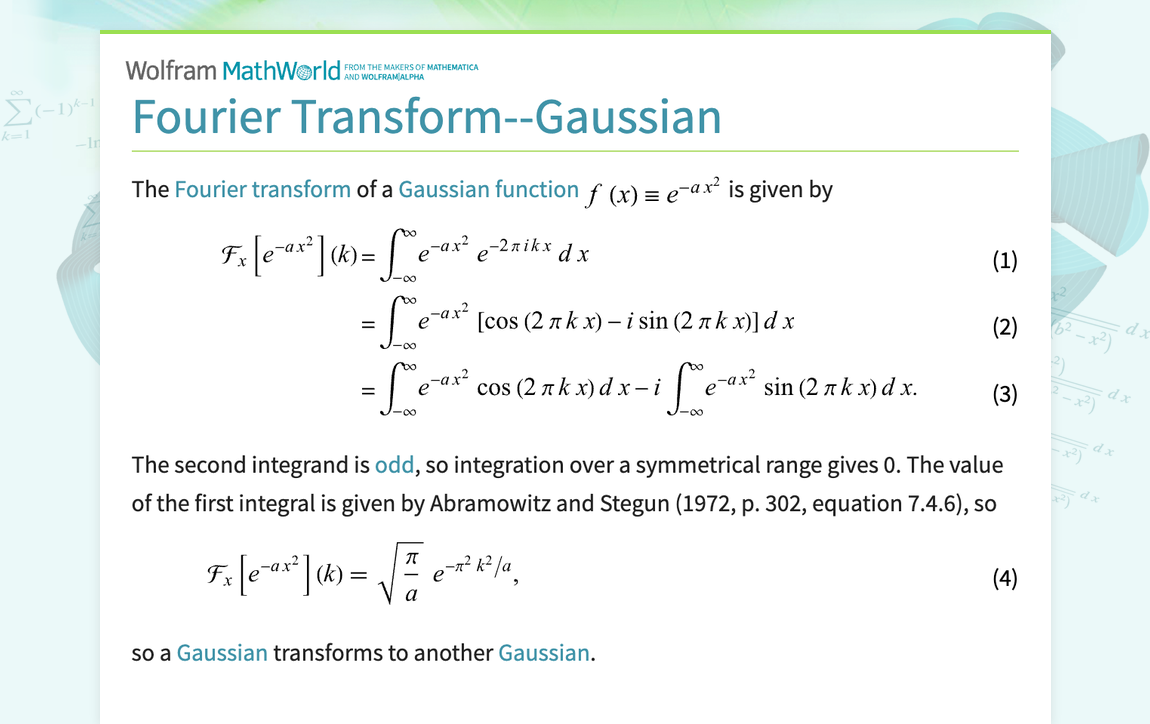
mathworld.wolfram.com/FourierTransformGaussian.html
Preview meta tags from the mathworld.wolfram.com website.
Linked Hostnames
5- 24 links tomathworld.wolfram.com
- 4 links towww.wolfram.com
- 4 links towww.wolframalpha.com
- 3 links towww.amazon.com
- 1 link towolframalpha.com
Thumbnail

Search Engine Appearance
Fourier Transform--Gaussian -- from Wolfram MathWorld
The Fourier transform of a Gaussian function f(x)=e^(-ax^2) is given by F_x[e^(-ax^2)](k) = int_(-infty)^inftye^(-ax^2)e^(-2piikx)dx (1) = int_(-infty)^inftye^(-ax^2)[cos(2pikx)-isin(2pikx)]dx (2) = int_(-infty)^inftye^(-ax^2)cos(2pikx)dx-iint_(-infty)^inftye^(-ax^2)sin(2pikx)dx. (3) The second integrand is odd, so integration over a symmetrical range gives 0. The value of the first integral is given by Abramowitz and Stegun (1972, p. 302, equation 7.4.6), so ...
Bing
Fourier Transform--Gaussian -- from Wolfram MathWorld
The Fourier transform of a Gaussian function f(x)=e^(-ax^2) is given by F_x[e^(-ax^2)](k) = int_(-infty)^inftye^(-ax^2)e^(-2piikx)dx (1) = int_(-infty)^inftye^(-ax^2)[cos(2pikx)-isin(2pikx)]dx (2) = int_(-infty)^inftye^(-ax^2)cos(2pikx)dx-iint_(-infty)^inftye^(-ax^2)sin(2pikx)dx. (3) The second integrand is odd, so integration over a symmetrical range gives 0. The value of the first integral is given by Abramowitz and Stegun (1972, p. 302, equation 7.4.6), so ...
DuckDuckGo
Fourier Transform--Gaussian -- from Wolfram MathWorld
The Fourier transform of a Gaussian function f(x)=e^(-ax^2) is given by F_x[e^(-ax^2)](k) = int_(-infty)^inftye^(-ax^2)e^(-2piikx)dx (1) = int_(-infty)^inftye^(-ax^2)[cos(2pikx)-isin(2pikx)]dx (2) = int_(-infty)^inftye^(-ax^2)cos(2pikx)dx-iint_(-infty)^inftye^(-ax^2)sin(2pikx)dx. (3) The second integrand is odd, so integration over a symmetrical range gives 0. The value of the first integral is given by Abramowitz and Stegun (1972, p. 302, equation 7.4.6), so ...
General Meta Tags
17- titleFourier Transform--Gaussian -- from Wolfram MathWorld
- DC.TitleFourier Transform--Gaussian
- DC.CreatorWeisstein, Eric W.
- DC.DescriptionThe Fourier transform of a Gaussian function f(x)=e^(-ax^2) is given by F_x[e^(-ax^2)](k) = int_(-infty)^inftye^(-ax^2)e^(-2piikx)dx (1) = int_(-infty)^inftye^(-ax^2)[cos(2pikx)-isin(2pikx)]dx (2) = int_(-infty)^inftye^(-ax^2)cos(2pikx)dx-iint_(-infty)^inftye^(-ax^2)sin(2pikx)dx. (3) The second integrand is odd, so integration over a symmetrical range gives 0. The value of the first integral is given by Abramowitz and Stegun (1972, p. 302, equation 7.4.6), so ...
- descriptionThe Fourier transform of a Gaussian function f(x)=e^(-ax^2) is given by F_x[e^(-ax^2)](k) = int_(-infty)^inftye^(-ax^2)e^(-2piikx)dx (1) = int_(-infty)^inftye^(-ax^2)[cos(2pikx)-isin(2pikx)]dx (2) = int_(-infty)^inftye^(-ax^2)cos(2pikx)dx-iint_(-infty)^inftye^(-ax^2)sin(2pikx)dx. (3) The second integrand is odd, so integration over a symmetrical range gives 0. The value of the first integral is given by Abramowitz and Stegun (1972, p. 302, equation 7.4.6), so ...
Open Graph Meta Tags
5- og:imagehttps://mathworld.wolfram.com/images/socialmedia/share/ogimage_FourierTransformGaussian.png
- og:urlhttps://mathworld.wolfram.com/FourierTransformGaussian.html
- og:typewebsite
- og:titleFourier Transform--Gaussian -- from Wolfram MathWorld
- og:descriptionThe Fourier transform of a Gaussian function f(x)=e^(-ax^2) is given by F_x[e^(-ax^2)](k) = int_(-infty)^inftye^(-ax^2)e^(-2piikx)dx (1) = int_(-infty)^inftye^(-ax^2)[cos(2pikx)-isin(2pikx)]dx (2) = int_(-infty)^inftye^(-ax^2)cos(2pikx)dx-iint_(-infty)^inftye^(-ax^2)sin(2pikx)dx. (3) The second integrand is odd, so integration over a symmetrical range gives 0. The value of the first integral is given by Abramowitz and Stegun (1972, p. 302, equation 7.4.6), so ...
Twitter Meta Tags
5- twitter:cardsummary_large_image
- twitter:site@WolframResearch
- twitter:titleFourier Transform--Gaussian -- from Wolfram MathWorld
- twitter:descriptionThe Fourier transform of a Gaussian function f(x)=e^(-ax^2) is given by F_x[e^(-ax^2)](k) = int_(-infty)^inftye^(-ax^2)e^(-2piikx)dx (1) = int_(-infty)^inftye^(-ax^2)[cos(2pikx)-isin(2pikx)]dx (2) = int_(-infty)^inftye^(-ax^2)cos(2pikx)dx-iint_(-infty)^inftye^(-ax^2)sin(2pikx)dx. (3) The second integrand is odd, so integration over a symmetrical range gives 0. The value of the first integral is given by Abramowitz and Stegun (1972, p. 302, equation 7.4.6), so ...
- twitter:image:srchttps://mathworld.wolfram.com/images/socialmedia/share/ogimage_FourierTransformGaussian.png
Link Tags
4- canonicalhttps://mathworld.wolfram.com/FourierTransformGaussian.html
- preload//www.wolframcdn.com/fonts/source-sans-pro/1.0/global.css
- stylesheet/css/styles.css
- stylesheet/common/js/c2c/1.0/WolframC2CGui.css.en
Links
36- http://www.amazon.com/exec/obidos/ASIN/0073039381/ref=nosim/ericstreasuretro
- http://www.amazon.com/exec/obidos/ASIN/0486612724/ref=nosim/ericstreasuretro
- http://www.wolframalpha.com/input/?i=Fourier+transforms
- https://mathworld.wolfram.com
- https://mathworld.wolfram.com/FourierTransform.html